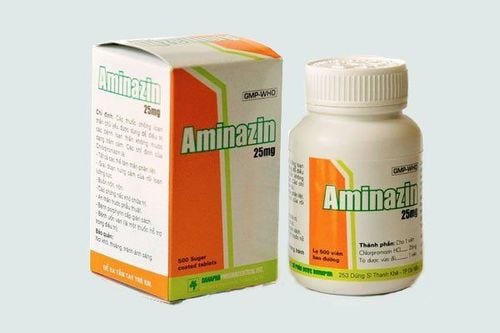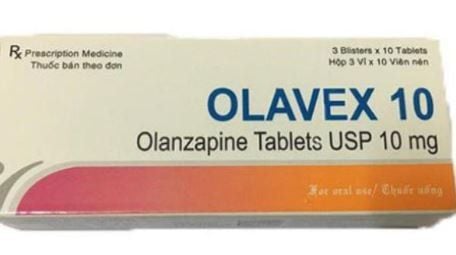This is an automatically translated article.
Egolanza belongs to the class of antipsychotic drugs, used to treat cases of schizophrenia. Refer to how to use Egolanza through the article below to better understand the use of the drug.
1. What is Egolanza?
Egolanza is made in the form of film-coated tablets, with the main ingredient Olanzapine (as Olanzapine dihydrochloride trihydrate) 10mg.
Olanzapine is an atypical antipsychotic and a dibenzodiazepine derivative. The drug has different pharmacological properties than typical antipsychotic drugs (derivatives of phenothiazines, butyrophenones) such as less extrapyramidal syndrome, decreased prolactin secretion, and less movement disturbance during prolonged treatment.
The antipsychotic mechanism of olanzapine has not been elucidated. This mechanism is related to the antagonism of serotonin types 2, 3, 6 and dopamine receptors on the central nervous system of the drug. Olanzapine also blocks dopamine D2 receptors, thus helping to stabilize mood. Olanzapine also antagonizes muscarinic receptors (M1, M2, M3, M4 and M5). The anticholinergic effects of olanzapine both reduce the risk of extrapyramidal syndrome and are associated with a number of other side effects.
In addition, the drug also has an antagonistic effect on histamine H1 receptors and alpha-1 adrenergic receptors, so it can cause drowsiness, orthostatic hypotension when taking the drug.
2. What are the effects of Egolanza?
Egolanza is used in the following cases:
Schizophrenia, bipolar disease: Manic or mixed exacerbations, acute agitation due to schizophrenia or bipolar disease, rapid cycling bipolar disease. Monotherapy of manic psychosis in adults and children 12-18 years of age (under close medical supervision). Do not use Egolanza in the following cases:
People who are sensitive to Olanzapine narrow-angle glaucoma Pregnant and lactating women
3. Dosage and how to use Egolanza
3.1. Dosage Egolanza drug dosage depends on each subject and disease condition:
Adults
Schizophrenia: The starting dose is 5 - 10 mg/time/day, can be increased by about 5 mg/day for 5-7 days up to the target dose of 10 mg/day. The post-dose adjustment phase is usually spaced at least 7 days apart, increasing or decreasing by 5 m/day up to a maximum dose of 20 mg/day. Maintenance dose: 10-20mg/time/day. Bipolar, acute or mixed manic episode: Monotherapy: Initially 10-15 mg/day, may be increased by 5 mg/day at least 24 hours apart. Maintenance dose 5 - 20mg/day. The maximum dose is 20 mg/day. Combination therapy (with valproate or lithium): Initially 10mg/time/day, dose may range from 5-20mg/day. Treatment of manic exacerbations (in combination with fluoxetin): Initial dose of olanzapine 6mg and fluoxetin 25mg. Elderly: Initially 2.5-5mg, after 2 hours can increase by 2.5-5mg if necessary. Children from 13 to 17 years old: Initial dose 2.5 - 5mg / time / day. The target dose is 10mg/day. The dose can be increased or decreased by 2.5mg or 5mg. Maximum dose 20 mg/day. Children under 13 years: Safety and effectiveness have not been established. No dose adjustment is required for patients with impaired renal function. Dose adjustment is required in patients with hepatic impairment who should be closely monitored. 3.2. How to take the drug The drug is taken orally, regardless of the meal, should be taken whole with water and taken at the same time each day.
4. Egolanza side effects
When using Egolanza, you may experience some of the following undesirable effects:
Central nervous system: Extrapyramidal syndrome, somnolence, insomnia, dizziness, speech disorder, fever, nightmares, mania Gastrointestinal disorders: Dry mouth, nausea, vomiting, dyspepsia, constipation, increased appetite, weight gain Increased liver enzymes ALT, AST Muscle weakness, tremor (with caution in the elderly) Chest pain, hypotension pressure, tachycardia, peripheral edema Endocrine-metabolic disorders: Hypercholesterolemia, hyperglycemia, hyperprolactinemia Conjunctivitis, decreased vision Leukopenia and neutropenia Prolonged QT interval on imaging Electrocardiogram Seizures, increased sensitivity to light. When using Egolanza, if the patient experiences any serious side effects, stop taking the drug and contact the treating doctor or medical facility for timely treatment.
5. Interactions with Egolanza
When using Egolanza in combination may interact with some of the following drugs:
Co-administration of olanzapine with levomethadyl is not recommended due to the increased risk of cardiotoxicity (QT prolongation, torsades de pointes, cardiac arrest), nor in combination with metoclopramide due to an increased risk of extrapyramidal syndrome, neuroleptic malignant syndrome. Concomitant use with CNS depressants such as alcohol, benzodiazepine derivatives enhances the orthostatic hypotensive effect of olanzapine. Concomitant administration of olanzapine with dopamine, adrenaline or other beta-adrenoceptors is not recommended because of the potential for aggravation of hypotension due to olanzapine's alpha-blocking effect. CYP450 inhibitors (cafein, erythromycin, ciprofloxacin, cimetidine, quinidine, some antidepressants such as fluvoxamine) increase the effects and toxicity of the drug. Inducers of CYP450 (carbamazepine, phenobarbital, phenytoin, rifampicin, omeprazole, nicotine) decrease blood concentrations and effects of olanzapine. Olanzapine enhances the effects of anticholinergic drugs (dry mouth, constipation, urinary retention, visual disturbances, sedation), in addition to enhancing the antihypertensive effect of antihypertensive agents. Olanzapine should not be used concurrently with drugs used to treat Parkinson's disease because of the potential for decreased drug effects.
6. Notes and cautions when using Egolanza
When using Egolanza, the following issues should be taken with caution:
Caution should be exercised in elderly people with dementia-related mental disorders due to an increased risk of death, mainly from cardiovascular causes (sudden death). , heart failure ) or bacterial infection ( pneumonia ). Children 13 to 17 years of age are at higher risk of weight gain and hyperlipidemia than adults, so risk assessment and close monitoring are needed when taking the drug. Use with caution in patients with benign prostatic hypertrophy, narrow-angle glaucoma or those with a history of paralytic ileus due to the drug's anticholinergic effects. Use with caution in patients with heart disease, cerebrovascular disease or conditions at risk of hypotension (volume depletion, dehydration, being treated with antihypertensive drugs) due to an increased risk of hypertension. causes postural hypotension with bradycardia, syncope, or sinus node arrest. The drug has a sedative effect, so caution should be exercised against the risk of decreased concentration and motor activity associated with the drug. Use with caution in patients with diabetes because of the risk of hyperglycemia, which may even be uncontrolled when the drug is stopped, so blood glucose should be monitored during treatment. With caution in people with impaired liver function or taking drugs that are toxic to the liver. Caution should be exercised in people with a history of head trauma, epilepsy or being treated with drugs capable of lowering the seizure threshold. The safety of the drug in pregnant women has not been verified, so it should be used with caution and only when carefully weighing the risks and benefits before assigning it to this population. The drug can be excreted in breast milk, causing central nervous system depression in nursing infants, so the drug should not be used by nursing women or not breast-feeding when taking the drug to the mother. In the process of taking the drug, be careful when driving or operating machinery because the drug can cause dizziness and drowsiness. In addition to the above information, if you have any questions about Egolanza, you can contact your doctor for advice and answers.
Please dial HOTLINE for more information or register for an appointment HERE. Download MyVinmec app to make appointments faster and to manage your bookings easily.













